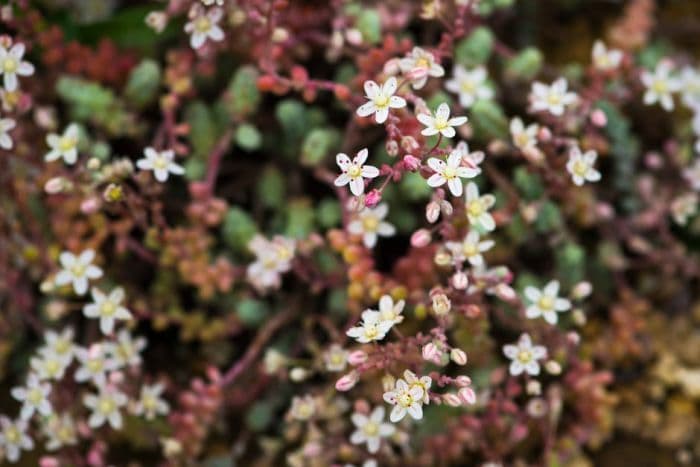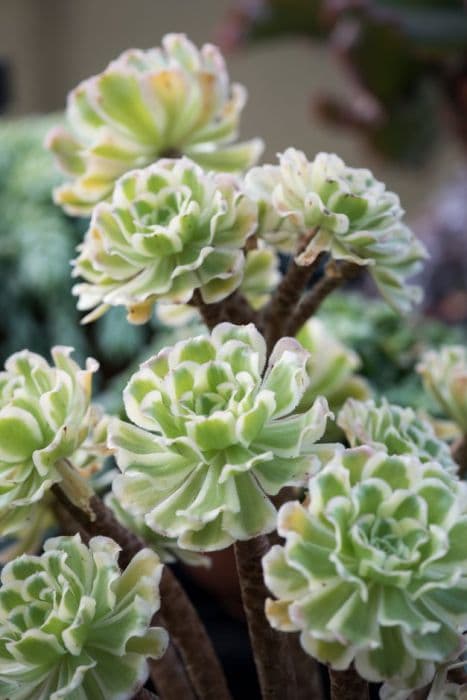Dwarf Stonecrop Sedum brevifolium

ABOUT
Sedum brevifolium, commonly known as Short-leaved Stonecrop, is a succulent plant that is known for its distinctive appearance. It has small, plump, fleshy leaves that form clusters resembling mats or cushions. The leaves are typically green but can take on reddish hues during colder temperatures or under stress. The plant has a spreading habit, with stems that lie flat on the ground or slightly ascend. The leaves grow densely along these stems, giving the plant a packed and robust look. In terms of the leaves' shape, they are rounded and can be described as stubby or short, giving the common name "Short-leaved" its meaning. When the Short-leaved Stonecrop blooms, it produces clusters of small, star-shaped flowers. These can be yellow, white, or pink, depending on the specific variety, and they rise just above the foliage on thin, erect stems. The contrast between the fleshy leaves and the delicate flowers adds to the plant's ornamental appeal. These plants are particularly known for their hardiness and ability to thrive in rocky or poor soil. They often feature prominently in alpine gardens, rock gardens, or as groundcovers, due to their low-growing, spreading nature. Please note, as requested, no specific measurements regarding the size of the plant have been mentioned.
About this plant
 Names
NamesFamily
Crassulaceae
Synonyms
Shortleaf Stonecrop
Common names
Sedum brevifolium.
 Toxicity
ToxicityTo humans
Sedum brevifolium, commonly known as the Short-leaved Stonecrop, is generally considered non-toxic to humans. Ingestion of this plant does not typically result in poisoning or severe adverse effects. However, as with many plants, individual sensitivities can vary, and ingestion of any plant material may cause mild gastrointestinal upset in some people, such as nausea or diarrhea.
To pets
Short-leaved Stonecrop is generally recognized as safe for pets as well. It is not known to be toxic to cats, dogs, or other animals. While it's not common for pets to experience poisoning from ingesting this plant, as with humans, some pets might exhibit mild gastrointestinal upset if they consume it, including symptoms like vomiting or diarrhea. Owners should still be cautious and prevent pets from eating plants as a general safety measure.
 Characteristics
CharacteristicsLife cycle
Perennials
Foliage type
Evergreen
Color of leaves
Green
Flower color
White
Height
0-6 inches (0-15 cm)
Spread
0-12 inches (0-30 cm)
Plant type
Succulent
Hardiness zones
9
Native area
Mediterranean
Benefits
 General Benefits
General Benefits- Low Maintenance: Sedum brevifolium, commonly known as Stonecrop, is a drought-tolerant plant requiring minimal care and water once established.
- Ground Cover: Its ability to spread quickly makes it an effective ground cover that can help reduce soil erosion.
- Aesthetic Appeal: The plant adds visual interest to gardens with its fleshy green leaves and bright yellow flowers.
- Attracts Pollinators: Stonecrop flowers attract bees, butterflies, and other beneficial pollinators to the garden.
- Hardy Plant: Sedum brevifolium is known for its hardiness, capable of withstanding harsh conditions, including poor soil and extreme temperatures.
- Versatile: It can be used in rock gardens, container gardens, and on green roofs, showcasing its adaptability to various landscapes.
 Medical Properties
Medical PropertiesThis plant is not used for medical purposes.
 Air-purifying Qualities
Air-purifying QualitiesThis plant is not specifically known for air purifying qualities.
 Other Uses
Other Uses- Sedum brevifolium, commonly known as Short-leaved Stonecrop, can be used as a living mulch in gardens, helping to retain soil moisture and suppress weeds because of its dense, ground-covering growth habit.
- The plant is often used in green roofing projects, as it is hardy and can thrive in shallow, nutrient-poor soils typically found on roof substrates.
- Short-leaved Stonecrop's ability to endure drought makes it an ideal candidate for xeriscaping, helping to reduce the need for irrigation in arid climate gardens.
- The succulent leaves of Short-leaved Stonecrop can add texture and visual interest to rock gardens, where its small stature and evergreen nature maintain year-round appeal.
- This species can be used in fairy gardens or miniature landscapes due to its small scale and easy-to-trim nature, making it manageable for tiny settings.
- Short-leaved Stonecrop can serve as a ground cover between stepping stones or pavers, softening the appearance of the hardscape while tolerating light foot traffic.
- The plant's colorful foliage, which can range from green to red-tinged, provides visual interest in winter gardens when many plants have died back or gone dormant.
- Short-leaved Stonecrop, because of its shallow root system, is an excellent choice for container gardens, especially those crafted with limitations on soil depth.
- It can be used in hanging baskets to create a cascading effect, as its stems and leaves can gently drape over the basket's edge.
- Short-leaved Stonecrop, with its drought-tolerant properties, is suitable for creating ornamentation in challenging urban conditions where water conservation is essential.
Interesting Facts
 Feng Shui
Feng ShuiThe Sedum is not used in Feng Shui practice.
 Zodiac Sign Compitability
Zodiac Sign CompitabilityThe Sedum is not used in astrology practice.
 Plant Symbolism
Plant Symbolism- Resilience - Sedum brevifolium, commonly known as the Stonecrop, is known for its ability to thrive in harsh, rocky environments, symbolizing the capacity to endure and flourish despite challenging conditions.
- Adaptability - Stonecrops can adapt to various soil types and levels of sunlight, reflecting the ability to adjust to different situations and make the best out of them.
- Healing - In some cultures, Stonecrops are believed to have medicinal properties, making them symbolic of healing and recovery.
- Perseverance - Their persistent growth and hardy nature embody the spirit of perseverance in overcoming obstacles.
- Tranquility - The Stonecrop is often used in gardens and green roofs to create a sense of peace and tranquility, illustrating its association with calmness and repose.
 Water
WaterThe Short-leaved Stonecrop (Sedum brevifolium) requires minimal watering as it is a drought-tolerant succulent. During its growing season in spring and summer, water the plant once every 1-2 weeks with about 4-6 ounces of water, or until the soil feels moist at a depth of 1 inch. Always allow the soil to dry out completely between waterings to prevent root rot. In the fall and winter, reduce watering to once a month or less, depending on the humidity of your environment. Ensure proper drainage in the plant's pot to avoid water accumulation at the base.
 Light
LightShort-leaved Stonecrop thrives in full sun to partial shade. It performs best when placed in a location where it receives at least 6 hours of sunlight a day. An east or west-facing windowsill is ideal for indoor plants, while an outdoor spot that gets bright, indirect sunlight during the hottest part of the day is optimal to prevent leaf scorch.
 Temperature
TemperatureShort-leaved Stonecrop prefers temperatures that range from 60°F to 75°F but can survive in temperatures as low as 20°F and as high as 90°F. Avoid exposing the plant to temperatures below 20°F for prolonged periods to prevent freeze damage. This plant enjoys a mild climate and should be protected from extreme temperature fluctuations.
 Pruning
PruningPrune Short-leaved Stonecrop to remove any dead or damaged leaves and to maintain its shape. Pruning can be done at any time of the year, but the best time is in early spring before new growth begins. Cut back up to one-third of the plant's size to encourage bushier growth. Pruning once a year is typically sufficient.
 Cleaning
CleaningAs needed
 Soil
SoilShort-leaved Stonecrop prefers a well-draining soil mix; combining 50% potting soil with 50% perlite or coarse sand is ideal. The best pH range for Short-leaved Stonecrop is slightly acidic to neutral, around 6.0 to 7.0.
 Repotting
RepottingShort-leaved Stonecrop should be repotted every two to three years to refresh the soil and provide room for growth. The best time to repot is during the spring or early summer.
 Humidity & Misting
Humidity & MistingShort-leaved Stonecrop thrives in low to moderate humidity levels, typical of what you find in most homes. They do not require high humidity to prosper.
 Suitable locations
Suitable locationsIndoor
Place Short-leaved Stonecrop in bright light and a warm spot indoors.
Outdoor
Ensure full sun to partial shade and good drainage for Short-leaved Stonecrop.
Hardiness zone
Short-leaved Stonecrop is suitable for USDA zones 6-9.
 Life cycle
Life cycleSedum brevifolium, commonly known as Short-leaved Stonecrop, begins its life cycle as a seed that germinates in spring, requiring well-drained soil and plenty of sunlight. Upon germination, it develops a shallow root system and succulent leaves that store water, transitioning into a vegetative stage characterized by rapid foliage growth. During its maturity phase in late spring to early summer, Short-leaved Stonecrop produces clusters of star-shaped flowers, usually in shades of yellow, that attract pollinators. After pollination, flowers give way to seed capsules that release seeds once they dry, completing the reproductive cycle. In colder climates, Sedum brevifolium enters a period of dormancy in the winter, with leaves sometimes dying back, only to regrow from the rootstock with the return of warmer temperatures. This stonecrop can also propagate asexually through leaves or stem cuttings that readily root and establish new plants.
 Propogation
PropogationPropogation time
Spring-Summer
Sedum brevifolium, commonly known as the "Short-leaved Stonecrop," is best propagated during its active growth period, which typically falls in the spring and early summer. The most popular method of propagation for Short-leaved Stonecrop is through leaf cuttings. To propagate, take healthy leaves from the plant and allow them to callous for a few days until the cut ends have dried. Once calloused, place the leaves on top of well-draining soil, barely covering the base but not burying them completely. Keep the soil slightly moist, and in a few weeks, roots and new shoots should start to develop from the base of the leaves. This easy and efficient method harnesses the plant's natural ability to regenerate and is an excellent way for gardeners to expand their collection or share with others.









